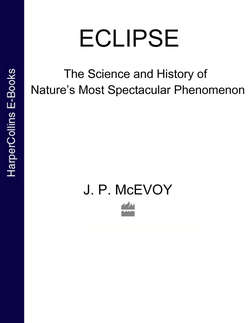Читать книгу Eclipse: The science and history of nature's most spectacular phenomenon - J. McEvoy P. - Страница 15
THE ECLIPTIC LIMIT
ОглавлениеIf the Sun at new Moon is aligned exactly with a node, it is obvious that there will be a solar eclipse. But the new Moon does not have to be exactly at a node for a solar eclipse to occur. Whenever the new Moon is close enough to the node for the two disks just to touch, there will be at least a partial solar eclipse. Look at the position of the Sun and new Moon on the celestial sphere with their disks just touching, in Figure 1.9. This position gives the maximum angular distance the new Moon can be from the node for there to be an eclipse. This distance is known as the ecliptic limit. If the total spread of the ecliptic limit, east plus west, is known as well as the speed of the Sun and Moon, it is possible to calculate the frequency at which eclipses can happen. Figure 1.10 shows a close-up of a part of the ecliptic centred on a node. (The node selected is a descending node, for consistency with examples of eclipses discussed in later chapters.)
The angular spread of the ecliptic limit depends on the tilt of the Moon’s orbit, which is a little over 5°. It also depends on the apparent size of the Sun and the Moon which, as we have seen, can vary because the orbital distances of the Earth and the Moon are always changing. Using the appropriate orbital parameters, the maximum angle of the ecliptic limit is found to occur when the Moon is at perigee and the Earth is at perihelion. In this configuration the two disks have their maximum sizes and will ‘touch’ at a point farthest from the node. This is calculated to be 37.02°, corresponding to a window of about 37.5 days. The minimum is 30.70° for the Moon at apogee and Earth at aphelion. In this case, the two disks have their minimum sizes as seen from the Earth, and will just touch at a point closer to the node. The ecliptic limit can be regarded as a ‘danger zone – if a new Moon occurs while the Sun is within this region, there will be a solar eclipse.
Figure 1.10. The ecliptic limits at a descending node (new Moon in each case).
Now, in a synodic month of 29.53 days, from one new Moon to the next, the Sun will move a certain fraction of an eclipse year along the ecliptic. This can be calculated as the ratio of the number of days in a synodic month to the number of days in an eclipse year: or 29.53/346.62, which makes 0.085. This fraction of one total revolution of 360° is 30.67°, very close to but less than the minimum angle of the ecliptic limit.
From this result a very interesting conclusion can be drawn. The minimum value of the ecliptic limit, 30.70°, is greater than the angle the Sun moves through during a complete synodic period of the Moon, 30.67°. The Sun will therefore never have enough time to pass through the ecliptic limit without being over-taken by a new Moon, so at least one solar eclipse is inevitable at each node, or two per calendar year. If the orbital conditions are optimum, with the Moon at perigee and the Earth at perihelion, the maximum ecliptic limit of 37.02° applies. The same calculation indicates that two eclipses are possible at each node, for a total of four solar eclipses in a year. The concept of the ecliptic limit thus provides a convenient way of predicting the properties of solar eclipses. It will also prove useful when it comes to explaining the characteristics of the saros series of eclipses.
